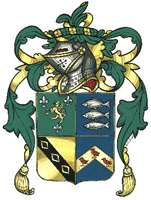
TREVATHAN FAMILY
 |
Canadian
TREVATHAN FAMILY |
|
07-April-2014 |
| I |
This page is still under construction please call again soonSamuel Trevethan - Born St. Issey 1867.David Trevethan 1826-1892, the father of those who came to New Zealand, had a brother John 1831-1898 who married Jane Moss on the 14th of October 1854 and worked as an agricultural labourer in the St. Issey area. They had five of a family, three boys and two girls and by 1861 lived at Lower Tredore which is within easy walking distance of St. Issey.Of interest to us is their youngest boy Samuel Zachariah Trevethan who was born in 1867 and presumably was given his second name after his uncle Zachariah Trevethan whose photo is on the Porthcothan Page in connection with the fall of the St. Issey church bell tower in 1869. Young Samuel went on to marry Elizabeth Saundry which could well be his uncles David’s wives niece of the same name.Samuel who was known as “Kyi” left Cornwall along with many other young people of the time but instead of Australia or New Zealand like his cousins he choose Canada and went to help with the construction of the Great Western Railway. Of interest is some information extracted from a book “Hamilton, An Illustrated History” by John C Weaver.A special meeting of the Hamilton, Ontario city council voted to approve purchase of stock in The Great Western Railroad on 29 August 1849. The boost to Hamilton economy came immediately. Railway construction had slowed in New York State, so equipment from Rochester, New York and Buffalo, New York flowed into Hamilton during the summer of 1850 and 1851. Contractors Moore, McElroy, and Pierson, imported two stem excavators used in New York State. Sam Farwell, who had constructed a portion of the New York and Erie Railroad brought his equipment through Port Hamilton.As construction began, the iron moulding and machinist trades grew. Foundrymen bid to construct roughly 450 railway cars between the summer of 1852 and 1853. By 1855-57 it is likely that railway had replaced navigation as the principal means of immigrant travel. Beginning in 1856, the town of Clifton surpassed the town of Quebec City as a port of entry for Canadian immigrants. Passengers from the New York County line disembarked on the American side of the suspension bridge. The peak year (1857) saw 32,000 immigrants entering Canada by the suspension bridge.There was a major catastrophe on the 12th of March 1857 when a Great Western Railway train plunged through a bridge over the Desjardins Canal and killed sixty people. There was a major shake-up during this time when stocks were sold illegally, double-dealing occurred, and one man’s attempt to take control of the Great Western Railway failed. In 1857, financial panic meant that the new southern lines could not raise capital. The city of Hamilton, having had seven years of prosperity, was now headed for seven lean years. A reasonable estimate of population loss between 1858 and 1862 would be about twenty per cent. The city of Hamilton had to suspend interest in payments on its bonds. In 1861, twenty one per cent of the city’s housing stock had become vacant. The American Civil War, tension between the United States and Great Britain, and especially the announced intention of the United States not to renew a reciprocal trade agreement with Canada upset the important trade links.Vacated dwellings were not being filled by newcomers; immigration had slowed to a trickle. The collapse of the railway boom struck down a number of industries supplying rolling stock, and to a minor degree, locomotives. Daniel Gunn’s locomotive works, which had constructed four engines for the Great Western Railway using English patterns, was one of the victims. Being forced to close his doors, he left creditors and 100-150 unemployed. The Great Western Railway was absorbed by Grand Truck Railway in 1882.How our Samuel fitted into all this period of Canadian history we don’t know but it appears that he and his family of six children later returned to Cornwall at some stage as some of his descendants still remain there today although his son John emigrated to Canada and remains there today.Johanna Trevethan - born 1792Huntingdon Township, Canada.
 Log Cabin that Johanna Trevethan lived in 1851. Taken 1979 |
|
| |
|
| Tree 120 |
This site was last updated 07-April-2014